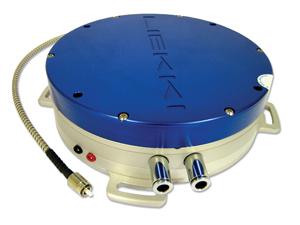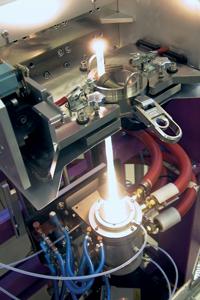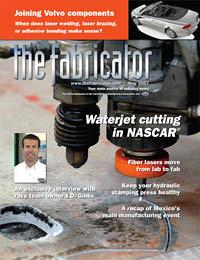Joona Koponen
- FMA
- The Fabricator
- FABTECH
- Canadian Metalworking
Categories
- Additive Manufacturing
- Aluminum Welding
- Arc Welding
- Assembly and Joining
- Automation and Robotics
- Bending and Forming
- Consumables
- Cutting and Weld Prep
- Electric Vehicles
- En Español
- Finishing
- Hydroforming
- Laser Cutting
- Laser Welding
- Machining
- Manufacturing Software
- Materials Handling
- Metals/Materials
- Oxyfuel Cutting
- Plasma Cutting
- Power Tools
- Punching and Other Holemaking
- Roll Forming
- Safety
- Sawing
- Shearing
- Shop Management
- Testing and Measuring
- Tube and Pipe Fabrication
- Tube and Pipe Production
- Waterjet Cutting
Industry Directory
Webcasts
Podcasts
FAB 40
Advertise
Subscribe
Account Login
Search
Fiber lasers weave out of the lab and into metal fab
Higher power, better beam control, more integration
- By Dr. Per Stenius
- May 8, 2007
- Article
- Laser Welding

Fiber lasers are more monolithic and integrated than most other laser types, making them suitable for portability.
Editor's Note: This article is based on the authors' presentation at the 2nd International Workshop on Fiber Lasers, Fraunhofer IWS, Dresden, Germany, July 2006, and a subsequent article that appeared in issue 5, November 2006, of Laser Technik Journal.
Fiber lasers, which have been a hot topic at laser conferences and industry meetings for several years now, are finally starting to appear en masse in the industrial laser market.
Although the laser per se is already an old invention, laser technology continues to develop as new supporting components and technologies emerge. While current workhorses such as CO2 lasers and lamp-pumped solid-state (LPSS) lasers are mature technologies, laser technology development in the last few years has been more active than ever with the introduction of fiber lasers.
In addition, the rate of performance improvement has increased. Fiber laser technology is driving power scaling (pulsed and continuous wave), wall-plug efficiency, and beam quality to new heights at a rapid pace.
These technological developments also are having an impact in the market. Although a lot of laser technologies are already available, such as CO2, LPSS, diode-pumped solid-state (DPSS), direct diode lasers, and disk lasers, fiber lasers are poised to open a new era in terms of performance, but even more important, in terms of cost.
There also are challenges. Unleashing the potential of fiber lasers is not easy; this is a laser technology more sophisticated than ever before, with heavy investments required in the underlying component manufacturing machinery and process, sophisticated final assembly, and extensive quality assurance. The need for heavy investment is driven by the fact that fiber laser technology is more monolithic and integrated than any laser technology before it.
What Is Different About Fibers?
In many ways, a fiber laser is just like any other laser. It has a cavity, a gain region, a pump source, and accurately put together components.
There are also differences. For example, the cavity mirrors in a fiber laser are formed by fiber Bragg gratings (FBGs), which are periodic structures in which variation of the refractive index in a piece of fiber provides reflection. In addition, the entire laser structure, including active and passive components, can be fused into a continuous fiber harness through a process called fusion splicing. This monolithic structure makes the system robust against external disturbances, such as vibration, and temperature changes.
Most important is that in fiber lasers the same structure — the active (or "doped") fiber — provides both waveguiding and gain. This enhances the beam quality of these lasers.
Just like cavity alignment in conventional laser manufacturing, assembling a fiber laser cavity— fusion splicing—needs to be done carefully. It requires high-precision tools and trained operators. The upside is that once the fiber laser has been assembled, it does not need further adjustment.
As with other laser technologies, all components in the fiber laser system must meet very stringent quality requirements and need to be made by companies with experience in mass production and good quality management. This is analogous to the processes instituted in the bulk optics industry.
Fiber Laser Advantages
While some controversy may exist about fiber laser benefits and their applicability for specific process applications, agreement is universal on the basic characteristics and advantages of fiber lasers:
- Durability: Fiber lasers can be built on telecom-grade components, which guarantee a long lifetime. For example, the pump diodes can have lifetimes of over 100,000 hours (single-emitter structures).
- Robust: Fiber lasers (including the associated pump diodes) are inherently monolithic, which makes them robust, requiring little or no maintenance.
- Simple Cooling: Thermal management is relatively straightforward because fiber lasers have a large surface ratio (and high efficiency) and so chillers and cooling mechanisms can be minimized.
- High Efficiency: Fiber lasers are highly efficient. This applies both to optical and wall-plug efficiency, which can reach close to 30 percent.
- Stable Beam Quality: Fibers provide both gain and mode guiding for the photon field, which makes it possible to achieve very bright laser output without sacrificing robustness of the system. The mode guidance of the fiber ensures that the beam quality is independent of the output power.
- Tunable: Because of the large gain bandwidth of ions in the glass of the fiber, fiber lasers are tunable in the frequency domain. The large gain bandwidth makes them suited for pulsed applications, even ultrashort pulses.
- Many Wavelengths: Fiber lasers are available in the 1-µm regime using ytterbium-(Yb) doped active fibers, as well as at 2-µm thulium (Tm) and 1.5-µm erbium (Er). Furthermore, Raman lasers offer access beyond the atomic bands of neodymium (Nd), Yb, Er, and Tm, and co-doping allows pumping, for example, at the Yb band, while providing gain at the Er band.
- Scalability: Fiber lasers provide an extremely scalable platform. More than 10-kilowatt power levels in continuous wave (CW) mode now are available. The beauty of this technology becomes evident when looking inside one of these high-power lasers—a large number of similar rack-mounted base units can be found. A typical multikilowatt laser consists of several 400- to 800-W base modules.
Fiber Laser Limitations
One of the technical limitations of current high-power (several kW) CW fiber lasers is that their output is randomly polarized rather than linearly polarized. While linearly polarized fiber lasers exist, they have not yet been scaled to multi-kW power levels.
A more practical limitation for fiber lasers is their novelty. In terms of their performance parameters (in particular, high beam quality and high peak power), fiber lasers are quite different from currently used lasers.
Because the polarization is random rather than linear (or circular), and the wavelength is different, this is a particular challenge in materials processing, where high process quality and stability requirements mean that processing parameters must be just right.
As fiber lasers enter new power domains (for example, CW lasers that have 30 to 50 kW), finding the right processing parameters for this new type of laser will remain crucial for its practical application.
Finally, although there are many technical advantages of fiber lasers, it is clear that this is a new technology, and like for all new technologies, there will be a learning curve associated with it.
Fiber Laser Applications
The largest and most immediate market for fiber lasers is in industrial manufacturing.
Low-power (10- to 30-W) pulsed or modulated CW fiber lasers provide precise control of pulse characteristics (energy and duration) and high beam quality, making them suitable for marking and micromachining (fine metal cutting and welding). In addition, their low maintenance need, good power conversion efficiency, simple air cooling, and compact size contribute to low operating costs and suitability for these applications.
Modulated CW fiber lasers in midpower ranges (100 to 200 W) are suitable for thin-sheet cutting and welding applications that are commonly found in parts production and the automobile industry. Again, beam quality and compactness are key features here. Fiber delivery of the beam to the workpiece adds additional flexibility often needed in the midrange applications. Durability and low maintenance also are crucial features.
In high-power applications (up to several tens of kilowatts), thick-sheet- metal cutting and welding are the most common applications. Beam quality is important, as is cutting and welding speed, but at this high power level, power conversion efficiency and maintenance cost also are very important buying criteria.
Fibers Reach for New Markets
Much of the discussion about fiber lasers has been focused on whether or not certain performance characteristics are better than those of other laser technologies (such as disk, solid-state/rod, or gas). While such debate certainly is important, it misses a key point — namely, the wide applicability of fiber laser technology, and the underlying scalability and volume economics.
CO2 laser technology, the workhorse of high-power CW lasers, is used primarily in cutting and welding industrial manufacturing. Low-power CO2 lasers, on the other hand, apply to basic marking applications. High-power solid-state lasers (rod and disk) have found a market in advanced industrial manufacturing, because they can provide a fiber-coupled output beam, allowing more process flexibility.
LPSS and DPSS lasers are widely used in marking applications, and DPSS lasers are also used in high-end applications for the semiconductor, medical, and scientific industries. Companies in the military, security, and aerospace sectors use solid-state technology, often using novel DPSS configurations like slabs and disks, but also other, advanced laser technologies.
It is fair to say that currently each laser market sector is served by a fairly specific technology, in some cases multiple technologies, and technology synergy is limited across the multiple sectors and product categories. This also implies that each laser technology applies to only a limited part of the overall laser market, and thus the market is fragmented.
Fiber laser technology challenges this. Because they are modular and flexible, fiber lasers can serve to unify the current fragmented markets. In addition, in many cases—for example, large-scale welding at shipyards or pipeline building, military applications such as minefield clearing, and hand-held lasers used in structural cutting and surface cleaning—fiber lasers have entered completely new markets.
The key point is that because fiber lasers use several common core components and submodules in all these different markets, they are able to capture economies of scale as never before. For the end user, this means lower cost and higher performance, which in turn allow more adaptation of laser technology tools and equipment across industries.
Using fiber lasers across many markets leads to another advantage—simplicity. Once the lasers are assembled, no additional setup is required, making the use of fiber lasers less resource-consuming.
A Road Block: Component Availability
While fiber lasers share many of the basic features and challenges with conventional lasers, they also represent a substantial step up in manufacturing process requirements.
First, the components used in fiber lasers, such as active and passive fibers; FBGs; high-brightness, fiber-coupled pump diodes; power combiners (both for diode pumps and output of individual fiber laser sources), all require highly advanced manufacturing technologies with capital-intensive fabrication facilities running with high fixed costs.
Fiber manufacturing itself is a complicated process, and the fibers required in high-power fiber lasers represent the pinnacle of fiber
technology in every aspect, from core composition and doping, to glass cladding and glassworks, to coating materials. Only a handful of companies are currently manufacturing the reliable, high-power, active fibers required.
High-brightness, fiber-coupled pump diodes also are needed; here the challenge is to achieve high output power, excellent efficiency, and very high brightness (in some cases, well over 10kW output from 105-µm fiber, and well over 50 W from 200-µm fiber). The investment required in an advanced wafer fab and a packaging facility capable of volume manufacturing of fiber-coupled diode lasers is high, just like the investment required in a fiber manufacturing facility.
The advanced technology, high investments, and high fixed costs have left the value chain scarcely populated, creating a road block for the laser industry to adopt fiber laser technology. Some companies have had to move up in the value chain, from being a components supplier to becoming a complete laser supplier. This, of course, further limits the supply chain.
Clearly, this type of scarcely populated value chain makes it difficult for fabricators to adopt fiber laser technology. There simply are not enough suppliers available to help bring the technology into real-life production.
Trending Into the Century of the Photon
The impact of fiber lasers on the laser industry will be interesting to watch. Because of the strong position of incumbent technologies, significant pressure will be put on price all the time. For fabricators, this is good news. Expect better performance — more integration, higher power, and better beam control — at lower cost, reduced maintenance, and easier operation of the laser.
For those interested in further technical developments in fiber lasers, there is a lot to look forward to. Ultralarge mode area fibers that provide single-mode output at ever-increasing powers are one of the many interesting research areas. New fiber structures, fibers with integrated functionality, and noncircular core/clad fibers should lower the cost of fiber lasers for years to come. Photonic crystal fibers may also open new applications in sectors such as medical and measurement. Coherent beam combining may open opportunities to create and control ultrahigh-power laser beams.
Increasingly monolithic systems and sophisticated manufacturing processes will make it possible to reduce manufacturing costs and increase reliability. High-efficiency diodes are expected to provide further improvement in wall-plug efficiency, helping to reduce the operative costs of fiber lasers.
Fiber laser technology is expected to continue its advancement and looks poised to be a key technology in most major laser application markets. All in all, fiber lasers and the underlying technologies will be crucial enablers in taking manufacturing into the "century of the photon."
Fiber Laser Components
Several components are critical in making a good fiber laser. Each component has specific challenges:
Dr. Per Stenius is CEO and Joona Koponen is product manager, optical engines, Liekki Corporation, Sorronrinne 9, FI-08500, Finland 358-40-533-0793, per.stenius@liekki.com, joona.koponen@liekki.com, www.liekki.com. William R. Willson is U.S. president and vice president of sales and marketing, Liekki Inc., 2109 Puddingtons Patent Way, Gambrills, MD 21054, 410-451-8021, william.willson@liekki.com, www.liekki.com.
About the Author
subscribe now

The Fabricator is North America's leading magazine for the metal forming and fabricating industry. The magazine delivers the news, technical articles, and case histories that enable fabricators to do their jobs more efficiently. The Fabricator has served the industry since 1970.
start your free subscription- Stay connected from anywhere

Easily access valuable industry resources now with full access to the digital edition of The Fabricator.

Easily access valuable industry resources now with full access to the digital edition of The Welder.

Easily access valuable industry resources now with full access to the digital edition of The Tube and Pipe Journal.
- Podcasting
- Podcast:
- The Fabricator Podcast
- Published:
- 04/30/2024
- Running Time:
- 53:00
Seth Feldman of Iowa-based Wertzbaugher Services joins The Fabricator Podcast to offer his take as a Gen Zer...
- Industry Events
16th Annual Safety Conference
- April 30 - May 1, 2024
- Elgin,
Pipe and Tube Conference
- May 21 - 22, 2024
- Omaha, NE
World-Class Roll Forming Workshop
- June 5 - 6, 2024
- Louisville, KY
Advanced Laser Application Workshop
- June 25 - 27, 2024
- Novi, MI
































